
|
|

March 3, 2006
Towers from the North Country: The Big Trip, 2005
Part IV: Minneapolis-St. Paul, round two
By SCOTT FYBUSH
Once every year or so, your editor gets together with other similarly radio-crazed folk for an event that's become known as "The Big Trip" - a week (or more) of dawn-to-dusk (and sometimes beyond) traveling in search of interesting new sites to showcase here on Tower Site of the Week, in the Tower Site Calendar, and so on. It's a chance for us to meet people we've only corresponded with via e-mail, and to gather airchecks and legal IDs for our new content partners at www.tophour.net, too. (In our version of a sitcom crossover episode, we're posting the legal IDs from each Friday's Tower Site installment the following Wednesday on Tophour - check it out!)
The fifth day of our 2005 Minnesota-Wisconsin trip, Monday, August 15, was one of the busiest days of tower-hunting and studio-visiting we've had in a long time - and an awfully productive one, at that.
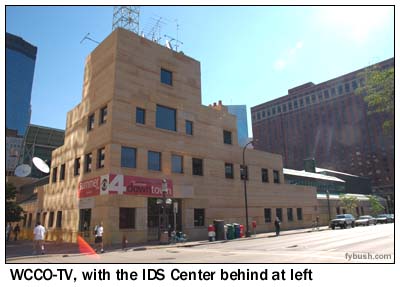 |
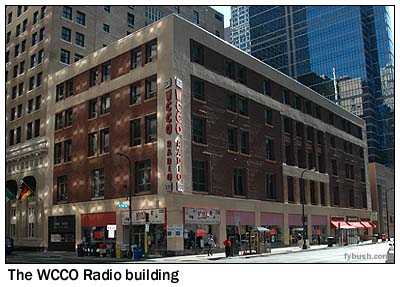
|
It began with an early visit to the Mall of America, just because one member of the traveling party (guilty as charged) felt that a visit to the Twin Cities wouldn't be complete without seeing what the nation's biggest mall looked like. With that out of the way, it was off to downtown Minneapolis, where we made a quick swing past the fancy studios that WCCO-TV (Channel 4) built in the nineties, then straight to the much older studios of CBS sister station WCCO (830), at 625 South 2nd Avenue.
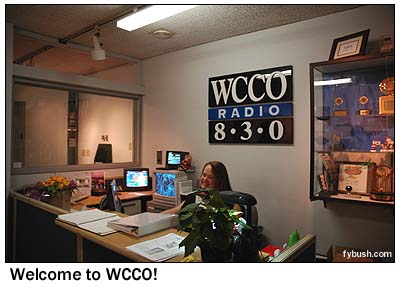
|
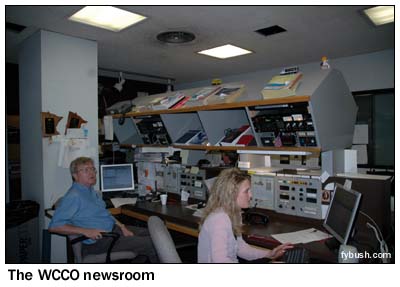
|
The WCCO studios aren't fancy, but they sure do get the job done. There's actually a long row of studios here, starting at one end with a big talk studio that was once WCCO's main air studio, then was used later on by erstwhile sister station KCCO (950) before that facility was sold, and is now vacant and awaiting renovation as the new newsroom. The current newsroom is next in line, followed by some production rooms, the engineering center (complete with a wall full of strange rectangular blue objects called "carts") and the enormous main studio, which functions as both a talk studio and a production center for the morning and afternoon news shows. (There's also a piano in the corner!)
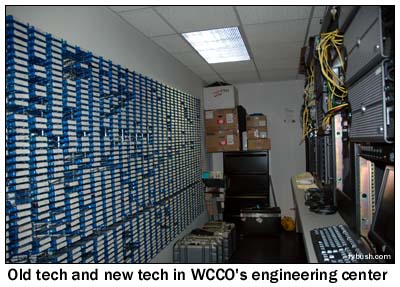
|
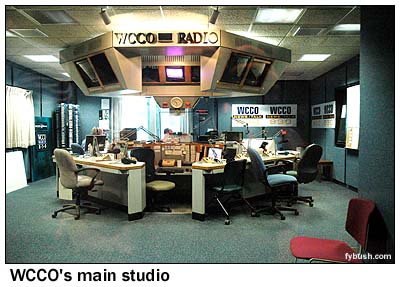
|
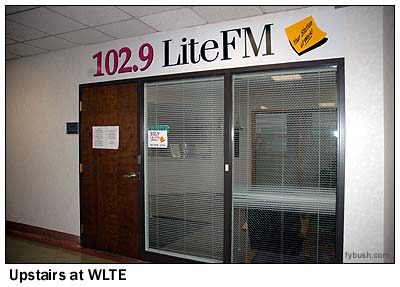 Upstairs,
we find the offices and studios of WCCO's FM sister, WLTE (102.9),
though WLTE no longer has a staffed lobby up here, instead sending
visitors down to the WCCO lobby to be greeted.
Upstairs,
we find the offices and studios of WCCO's FM sister, WLTE (102.9),
though WLTE no longer has a staffed lobby up here, instead sending
visitors down to the WCCO lobby to be greeted.
"102.9 Lite FM" grew from a forgotten stepsister to the big gun at 8-3-0 on the AM dial (for many years, WCCO-FM didn't even operate in stereo, or with maximum class C facilities) into an adult contemporary giant in its own right.
Like the big AM downstairs, WLTE has a functional, but far from magnificent, studio. It now has a cousin down the hall, too - Infinity (which would become CBS Radio right after our visit) picked up the St. Louis Park-licensed 104.1 signal at the same time it bought AM 950 a few years back. In April 2005, it flipped 104.1 from eighties hits "Mix 104" (WXPT) to "Jack FM" (KZJK), and moved the studios from the suburbs into the WCCO building.
It's a very interim studio facility (and may well have been rebuilt by the time you read this), with a bunch of equipment that was quickly moved out of the old WXPT facility and installed on folding tables in whatever way would fit. And while there are no live voices on this "Jack," there are live board ops, who have to reach up to get at the faders on the console, which had to be elevated to fit properly without having to cut a hole in the table.
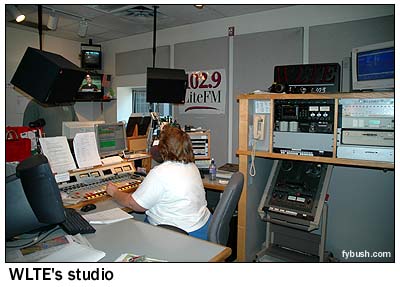 |
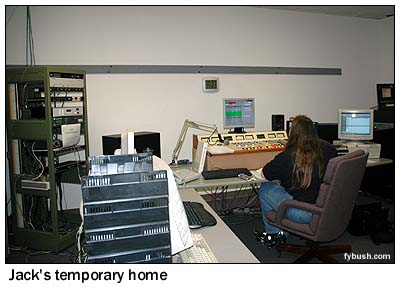
|
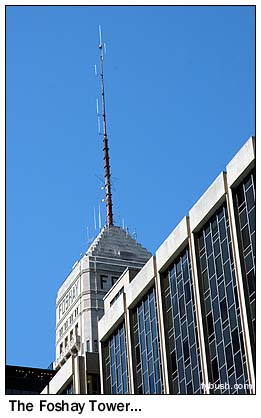
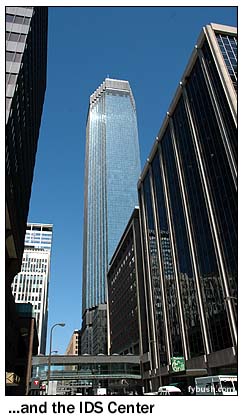 It would have been
nice to have had a few hours, at this point, to kick around downtown
Minneapolis and admire the urban architecture and the extensive
skyway system that allows people to move around the urban core
without ever stepping outside in winter.
It would have been
nice to have had a few hours, at this point, to kick around downtown
Minneapolis and admire the urban architecture and the extensive
skyway system that allows people to move around the urban core
without ever stepping outside in winter.
There's a lot to see here, including the 447-foot obelisk that is the Foshay Tower, built in the late twenties by real estate developer Wilbur Foshay. For many years, it was the tallest building - by far - on the city's skyline, and that of course made it a natural spot for early TV and FM broadcasting.
Three Twin Cities TV stations - WCCO-TV (Channel 4), KMSP (Channel 9) and WTCN-TV (Channel 11) used the Foshay as a transmitter site, as did several of the city's FM signals.
Then, in 1971, came the construction of a much taller skyscraper, the elegant 775-foot Philip Johnson tower known as the IDS Center.
The arrival of the IDS Center on the scene, soon accompanied by other towers considerably taller than the Foshay, made it inevitable that the radio and TV stations using the Foshay would need a new home. The TV stations moved up to Shoreview, northeast of Minneapolis, a story that we'll get to in some detail in a little bit. The FM stations moved to the IDS Center, building a master antenna system that proved to be problematic.
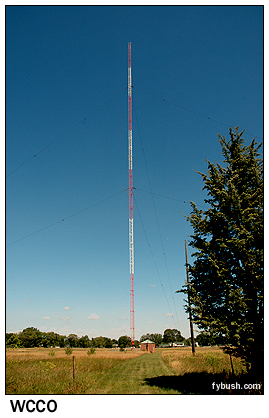 We'll
see how that was solved, too - but first, the reason we're in
a hurry to get out of downtown Minneapolis and up to the northern
suburb of Coon Rapids: a tour of the transmitter site of WCCO,
bringing us another step closer to our goal of visiting (and
sharing with all of you) the sites of all 25 of the former class
I-A clear channel AM stations in the U.S.
We'll
see how that was solved, too - but first, the reason we're in
a hurry to get out of downtown Minneapolis and up to the northern
suburb of Coon Rapids: a tour of the transmitter site of WCCO,
bringing us another step closer to our goal of visiting (and
sharing with all of you) the sites of all 25 of the former class
I-A clear channel AM stations in the U.S.
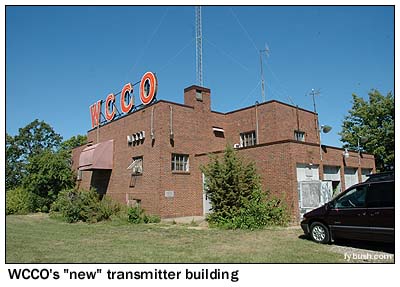 Coon
Rapids Boulevard (then US 10) must have been an awfully remote
rural spot way back in 1924, when WCCO went on the air out here,
almost within sight of the Mississippi River.
Coon
Rapids Boulevard (then US 10) must have been an awfully remote
rural spot way back in 1924, when WCCO went on the air out here,
almost within sight of the Mississippi River.
Back then, its "high-power" operation was all of 5,000 watts, using a horizontal wire antenna. But it didn't take long for WCCO to upgrade: in 1931, it made the move to 50,000 watts, building a new transmitter building a little closer to the road to house the gigantic Western Electric transmitter. In 1939, the wire antenna gave way to the 654-foot vertical tower that still stands here today.
Indeed, from the outside WCCO joins WLW and WSM in presenting an outward appearance almost unchanged from the golden age of radio. WCCO still has the huge call letters on the transmitter building (can you imagine building signage like that on a transmitter site today?), and there's even a small "Columbia Broadcasting System" plaque near the door that dates back to the first time CBS owned the station, starting in 1937.
Inside, a proper respect is shown to the history of the site, including a table full of vintage equipment and a wall of historic photos. That's the Western Electric shown below at right, looking a little wavery only because this is a photo of a photo. That control console, as you'll see, is still there - but instead of looking out over the WE and out to the tower, it looks at the current Harris DX50 main transmitter, far more efficient and reliable, but completely lacking the romance of the old Western.
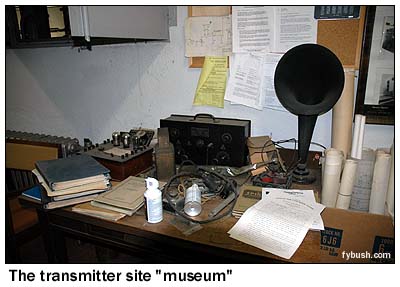 |
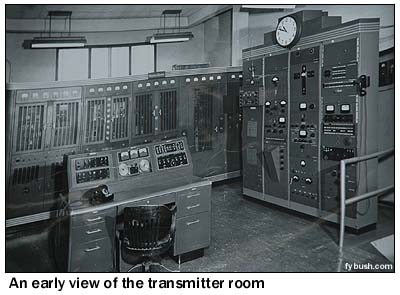
|
You can see the "today" version directly below the vintage photo, and it's evident that the wall above the DX50 wasn't there in the old days. To the left of the console sits a Continental 317C that was once WCCO's main transmitter and is now a backup. Engineering offices are at the front of the building, with additional workshop space up a flight of stairs and a big basement below that once housed all the power transformers for the Western and now sits mostly empty.
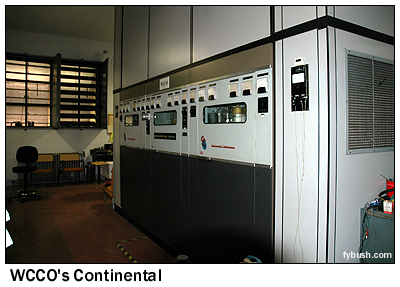 |
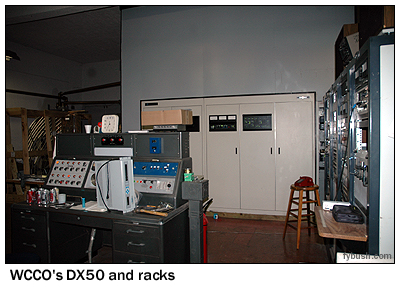
|
Neat? Absolutely - but there's still more history waiting outside. You see, when WCCO moved to the "new" transmitter building in 1931, it left the original 1924 building standing, and guess what? It's still there, at one edge of the property, with a concrete pad in front where one of the original support towers for the longwire antenna once stood.
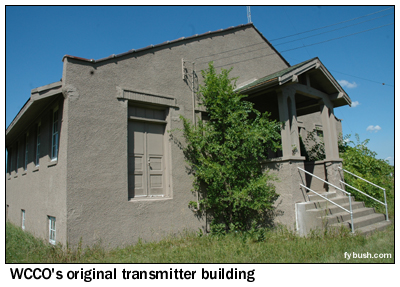 |
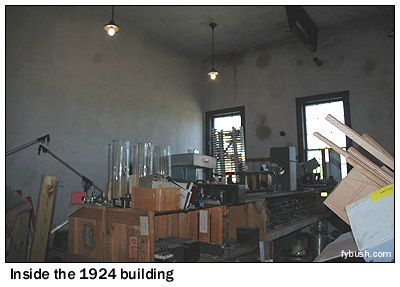
|
Today, the building is used for additional storage. Can you believe it once took this much space to hold just one 5,000-watt transmitter?
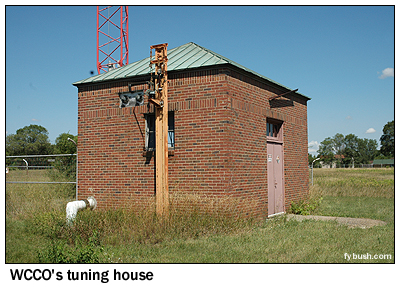 |

|
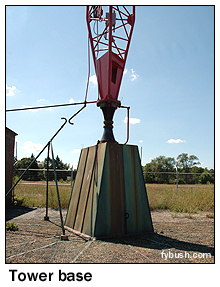
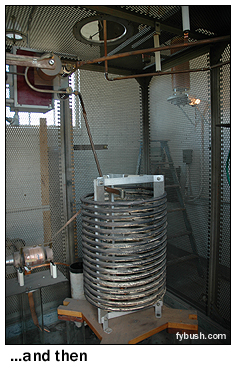 After
poking around the 1924 building for a while to see what's sitting
around, we head back to the tower itself.
After
poking around the 1924 building for a while to see what's sitting
around, we head back to the tower itself.
Even the tuning house here displays several generations of history, with a modern enclosed antenna tuning unit sitting next to the old matching network, which sits in a wire mesh cage that would probably give modern OSHA inspectors a heart attack. (Again, however - far more romantic than its pedestrian modern successor!)
Outside, the tower sits on a particularly tiny insulator - and you've gotta love the copper sheeting that covers the entire tower base leading out to the ground straps.
In this part of the world, ground conductivity's pretty good, and the WCCO signal is a local for many Minnesotans far beyond the Twin Cities.
(One more note before we leave WCCO: there is no auxiliary tower at the Coon Rapids site. Why not? Because WCCO's fortunate enough to have a completely separate auxiliary site a few miles to the north. We didn't get to see it on this trip, but we'll definitely have to make that a priority on a future visit.)
All that radio, and we're still only at lunchtime!
After bidding farewell to our host at WCCO, chief engineer Joe Joncas, we follow our other host for the day, veteran Twin Cities engineer Steve Brown of Radio Rangers LLC, to a relaxing lunch within view of another Twin Cities broadcasting landmark: the twin towers of the Telefarm complex in Shoreview, about eight miles southeast of the WCCO tower.
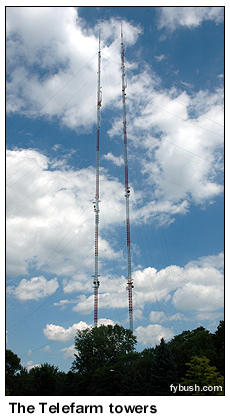 |
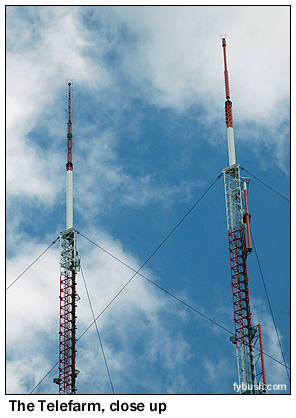 |
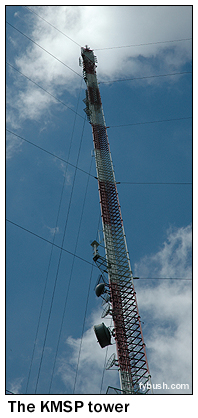 |
It's here that we rejoin the story of the Twin Cities' TV and FM signals after they'd outgrown the Foshay Tower. With the IDS Center rising, two of the Foshay TV signals (WCCO-TV 4 and WTCN-TV 11) joined forces with KSTP-TV 5, whose own tower behind its University Avenue studios was also about to be outgrown by the Minneapolis skyline, to build a huge new candelabra tower here in Shoreview.
The tower went up, reached the 1258-foot level, and then collapsed before it ever made it on the air, killing seven workers in one of the worst tower tragedies in American history. Instead of rebuilding it as a single candelabra tower, Dresser-Ideco instead built two towers, one for channels 4 and 5, the other for channel 11, but all jointly owned under an entity called "Telefarm, Inc.," which is still owned by the three stations. Each tower rises about 1437 feet, and each was rebuilt in 1999-2000 for digital television.
In addition to their original owners, the Telefarm towers now also house Sinclair WB affiliate KMWB (Channel 23), KSTP's independent sister station KSTC (Channel 45) and four FM facilities: KSTP-FM (94.5), its sister station WFMP (107.1 Coon Rapids), Minnesota Public Radio's KNOW (91.1) and an aux for WLTE.
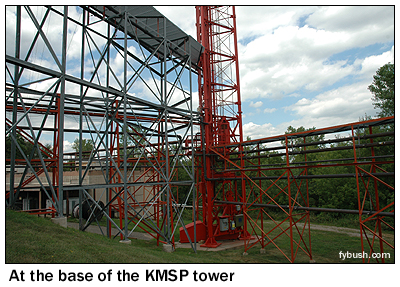 |
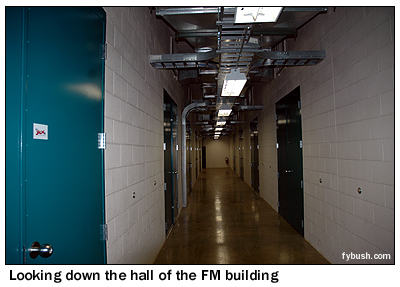 |
But the Telefarm towers aren't the only tall sticks in Shoreview - in fact, they're not even the tallest. That honor goes to another stick just a mile or so to the east, the 1466-foot tower that was built in 1971 by the other TV station displaced from Foshay, KMSP-TV (Channel 9). The KMSP tower was quickly shared by public TV KTCA (Channel 2)/KTCI (Channel 17), which had been on the relatively short KUOM tower that we showed you a few weeks ago. Later on, a new UHF outlet, KITN (Channel 29), joined them out here. Today, Channel 29 is WFTC, a UPN (soon to be My Network TV) affiliate that's co-owned with KMSP by Fox Television Stations, which also owns the tower.
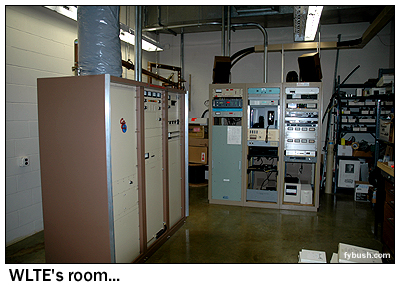 |
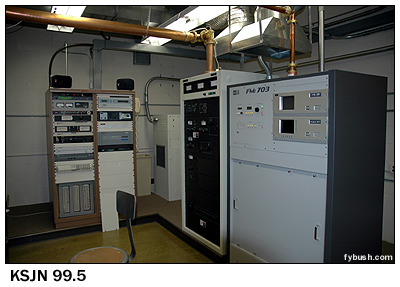 |
But this site is probably better known for the radio tenants here. We'd mentioned earlier that the IDS Center turned out to be an unsuccessful spot for FM radio in the Twin Cities. The stations that were up there ended up with nasty multipath problems in downtown Minneapolis, and the stations that weren't up there (including KSTP-FM and WCCO-FM/WLTE at the Telefarm) ended up being blasted out of listenability downtown from the overload and intermod that came from having so many big FM signals right in a downtown area.
And after many years of trying to make the whole mess work, the Twin Cities radio community got together and came up with a better idea: a master antenna on the KMSP tower to serve eight class C FM signals. The master antenna went on in 1989, and today, those eight stations are KQRS-FM (92.5), KXXR (93.7), KTCZ (97.1), KTIS-FM (98.5), KSJN-FM (99.5), KDWB-FM (101.3), KEEY-FM (102.1) and WLTE (102.9). They all now enjoy wonderfully clean signals over the entire metro - and they've since been joined by two more FMs here. KZJK (104.1) was a late addition to the combiner a few years ago, and what's now KTLK-FM (100.3) uses a separate antenna lower on the tower.
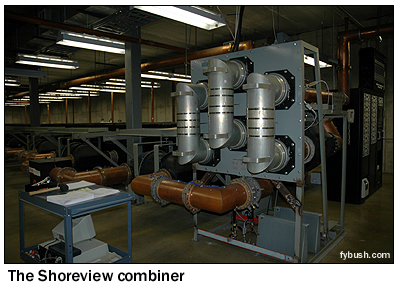 |
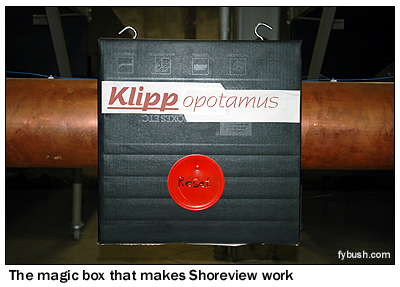 |
And because the facility was designed and built from scratch, with none of the space or power limitations of skyscraper master FM sites like the Empire State Building or Chicago's Hancock Center, the stations were able to build a showplace site. Upstairs, each station has its own spacious room with ample ventilation and backup power. (Check out all the toys Minnesota Public Radio has in the KSJN room - that's a brand-new BE IBOC transmitter on the right, and an Optimod FM-8500 in the processing rack, the first one we'd seen in the field.) Downstairs, the transmitters all feed into the combiner, built (as was the antenna) by the British firm of Alan Dick.
This is also the only site in the world to use the "Klippopotamus." Yes, it may look for all the world like a cardboard box painted black, with a coffee-can lid marked "Reset" on the front of it - but as anyone knows who's seen the parody video that Steve and friends did back in the mid-90s, during the heyday of heavy-duty composite clipping, this magic weapon is, in fact, "the hipper clipper with the big round sound," and yes, it does take those hooks on top to lift it into place on the output hardline of the combiner!
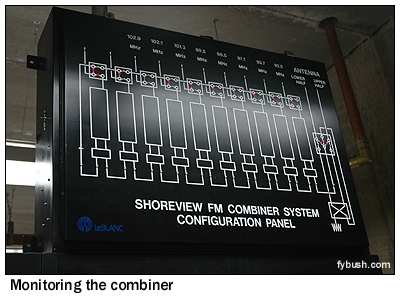 |
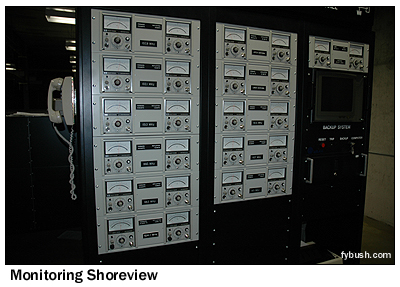 |
The antenna is actually two antennas, which usually are fed together, with a total power output from the combiner of a whopping 316 kilowatts. In case of emergency, though, each antenna can run by itself at half-power, and that big rack of HP power meters will tell you exactly what's going on.
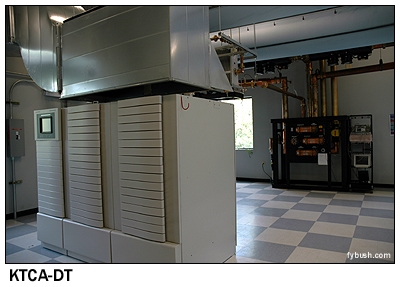 |
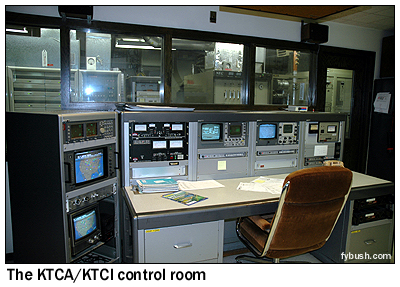 |
We get one more surprise visit while we're here: a quick tour of the KTCA/KTCI transmitter facility, including the new addition that houses the KTCA-DT (Channel 34) transmitter and the older part of the building that houses the Harris channel 2 transmitter, the NEC channel 17 transmitter and the KTCI-DT (Channel 16) transmitter, all glimpsed through the control-room window there. Twin Cities Public TV does something neat with their pair of DTs: KTCA-DT runs one high-quality HDTV stream, while all the standard-def multicasting takes place on KTCI-DT.
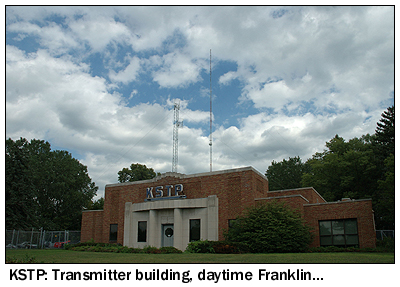
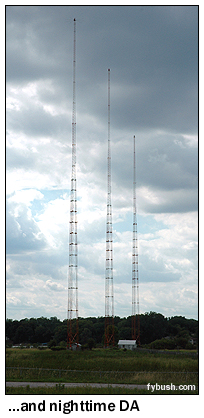 As we leave Shoreview,
we've still got one more "must-see" site on our Twin
Cities list: a couple of miles to the east, where I-694 crosses
US 61, we've long wanted to check out the 50 kilowatt site of
KSTP (1500).
As we leave Shoreview,
we've still got one more "must-see" site on our Twin
Cities list: a couple of miles to the east, where I-694 crosses
US 61, we've long wanted to check out the 50 kilowatt site of
KSTP (1500).
This is a doubly unusual site: first, because it's actually a two-site operation, with the nondirectional day signal coming from a tower east of US 61 and the three-tower night signal beaming west (away from WTOP in Washington) from the other side of the divided highway - and second, because that day tower is a massive Franklin antenna, one of only two true Franklins in the U.S. that we know of. (The other, of course, is Sacramento's KFBK, which we saw earlier in the summer.)
Any time you stack a half-wave antenna atop another half-wave antenna and feed them at the center, it's impressive, though this one is perhaps a little less visually imposing than KFBK's two huge towers, if only because it's much newer. The current 658-foot tower dates only to 1981, when it replaced an earlier tower that was damaged in a storm. And it's kind of cool to look across the busy highway to see where the very long transmission lines from the building come out at the night towers, too.
It's now time to beat the rush hour out of town as we head east for the Wisconsin state line and Eau Claire beyond, but three more AM sites await our attention on the way.
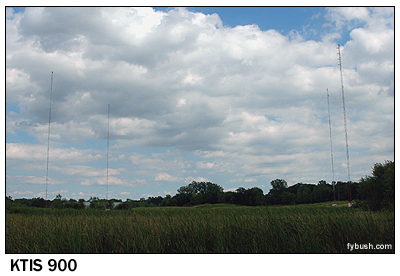 |
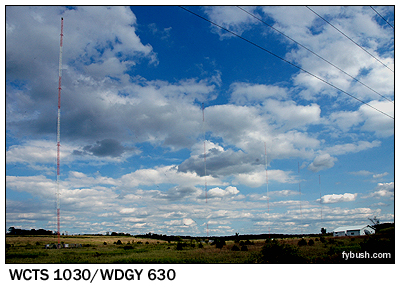 |
In Oakdale, where I-694 bends south to meet I-94, we find one of the newest AM sites in the market, the four towers of KTIS (900), which moved from an earlier, lower-powered site in the center of the market out to this location in 1989, jumping to 25 kW days (with a CP for 50 kW soon).
A year earlier, another AM station made a similar jump in reach. What was then WMIN (1010) changed city of license to Maplewood, moved to 1030, and went full-time with 50 kW days/1 kW nights from a five-tower array south of I-94 and well east of St. Paul. A few years later, the AM facility was sold to the Central Theological Seminary, which promptly sold its big-signal WCTS-FM (100.3) and moved the WCTS calls and format down to 1030.
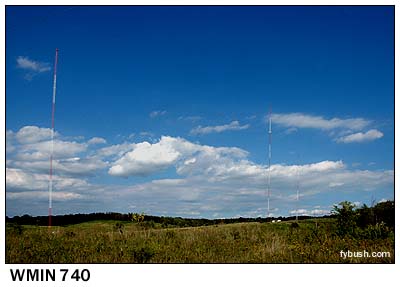 This
site acquired a second tenant a few years later, when KDWB (630
Minneapolis) lost its site. The license ended up moving to Hudson,
Wisconsin, taking over the facilities of the 740 daytimer there.
That station, which picked up the abandoned WMIN calls, then
moved to a diplex on the WCTS site.
This
site acquired a second tenant a few years later, when KDWB (630
Minneapolis) lost its site. The license ended up moving to Hudson,
Wisconsin, taking over the facilities of the 740 daytimer there.
That station, which picked up the abandoned WMIN calls, then
moved to a diplex on the WCTS site.
But wait - it gets better. Eventually, 630 (which along the way picked up the heritage WDGY calls that had long been at 1130 on the dial, now KFAN) switched places with co-owned 740 - so now it's WDGY 630 that operates from the 1030 site, while 740's back across the St. Croix River in Wisconsin, at the three-tower site where it began, just off I-94 a few miles west of the state line, running 1100 watts by day, with a pending CP to increase to 2500 watts. (630 also has a pending CP to change city of license to St. Paul, with a power increase.)
Whew - that's a lot of radio for one day, isn't it? Would you believe that after all that, still more awaited us that Monday evening in Eau Claire? Join us for that next Friday here at Tower Site of the Week, won't you?
- Previous Site of the Week: The Minnesota/Wisconsin Big Trip, part III: International Falls, Hibbing and back to St. Paul
- Next Week: The Minnesota/Wisconsin Big Trip, Part V: Eau Claire
- Site of the Week INDEX!
- How can you help support Site of the Week? Click here!
- Submit your suggestions for a future Site of the Week!
